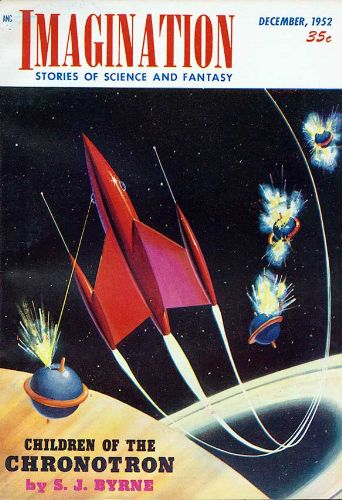|
Trurl And Klapaucius
Trurl and Klapaucius are the main protagonists of the humorous science fiction short stories of the '' Cyberiad'' series written by Polish writer Stanisław Lem. They are two robots who are constructors, who travel the galaxy, designing and building fantastic machines, either on order, or of their own fancy.Wojciech Orliński, ''Co to są sepulki? Wszystko o Lemie'' 'What are Sepulki? Everything about Lem'' 2007, , entires "Klapaucjusz" and "Trurl".Christopher FinnFound in Translation: ‘The Cyberiad, Fables for the Cybernetic Age’ by Stanisław Lem ''The Oxford Culture Review'', February 10, 2017 Their first appearance was in 1964, in a different, albeit similar series, ''Fables for Robots''. That they are robots is not stated anywhere directly, but is revealed through hints. For example, in the story "Altruizine" Trurl utters: "I, however, made bold to remind him of the solidarity of all thinking beings and the necessity of aiding our organic brothers". The illustrations o ... [...More Info...] [...Related Items...] OR: [Wikipedia] [Google] [Baidu] |
Protagonist
A protagonist () is the main character of a story. The protagonist makes key decisions that affect the plot, primarily influencing the story and propelling it forward, and is often the character who faces the most significant obstacles. If a story contains a subplot, or is a narrative made up of several stories, then each subplot may have its own protagonist. The protagonist is the character whose fate is most closely followed by the reader or audience, and who is opposed by the antagonist. The antagonist provides obstacles and complications and creates conflicts that test the protagonist, revealing the strengths and weaknesses of the protagonist's character, and having the protagonist develop as a result. A particularly noble, virtuous, or accomplished protagonist is commonly called a ''hero,'' though the terms are not synonyms. Etymology The term ''protagonist'' comes , combined of (, 'first') and (, 'actor, competitor'), which stems from (, 'contest') via (, 'I conten ... [...More Info...] [...Related Items...] OR: [Wikipedia] [Google] [Baidu] |
Science Fiction
Science fiction (often shortened to sci-fi or abbreviated SF) is a genre of speculative fiction that deals with imaginative and futuristic concepts. These concepts may include information technology and robotics, biological manipulations, space exploration, time travel, Parallel universes in fiction, parallel universes, and extraterrestrials in fiction, extraterrestrial life. The genre often explores human responses to the consequences of projected or imagined scientific advances. Science fiction is related to fantasy (together abbreviated wikt:SF&F, SF&F), Horror fiction, horror, and superhero fiction, and it contains many #Subgenres, subgenres. The genre's precise Definitions of science fiction, definition has long been disputed among authors, critics, scholars, and readers. Major subgenres include hard science fiction, ''hard'' science fiction, which emphasizes scientific accuracy, and soft science fiction, ''soft'' science fiction, which focuses on social sciences. Other no ... [...More Info...] [...Related Items...] OR: [Wikipedia] [Google] [Baidu] |
Cyberiad
''The Cyberiad'' (), sometimes subtitled ''Fables for the Cybernetic Age'', is a series of humorous science fiction short stories by Polish writer Stanisław Lem published during 1964–1979. The first collected set of stories was originally published in 1965, with an English translation by Michael Kandel first appearing in 1974. The main protagonists of the stories are Trurl and Klapaucius, two "constructor" robots who travel the galaxy, constructing fantastic machines. Nearly every character is either a humanoid robot or some sort of intelligent machine, with few living creatures ever appearing. These robots have for the most part organized themselves into proto-feudal societies with strict ranks and structures. The timeline of each story is relatively constrained, with the majority of the individual tales following one or both of the two protagonists as they find and aid civilizations and people in need of their creations, advice, or intervention. Though the thematic content ... [...More Info...] [...Related Items...] OR: [Wikipedia] [Google] [Baidu] |
Stanisław Lem
Stanisław Herman Lem (; 12 September 1921 – 27 March 2006) was a Polish writer. He was the author of many novels, short stories, and essays on various subjects, including philosophy, futurology, and literary criticism. Many of his science fiction stories are of satirical and humorous character. Lem's books have been translated into more than 50 languages and have sold more than 45 million copies. Worldwide, he is best known as the author of the 1961 novel ''Solaris''. In 1976, Theodore Sturgeon wrote that Lem was the most widely read science fiction writer in the world. Lem was the author of the fundamental philosophical work ''Summa Technologiae'', in which he anticipated the creation of virtual reality, artificial intelligence, and also developed the ideas of human autoevolution, the creation of artificial worlds, and many others. Lem's science fiction works explore philosophical themes through speculations on technology, the nature of intelligence, the impossibility ... [...More Info...] [...Related Items...] OR: [Wikipedia] [Google] [Baidu] |

